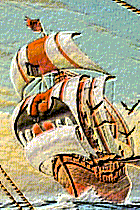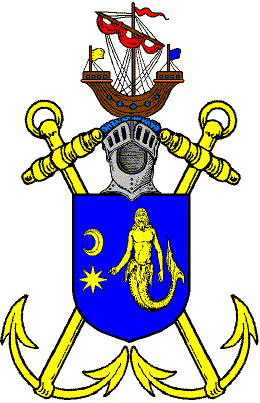


"... therefore we allow any Lord Knight, by appointment of His High
Knight, or by order of the Grand Master Himself, to acquire, hold, and sail a proper ship
under his command, so that His fellow Knights could take advantage of it, in peace as well
as in war. Such a ship will bear the blazon of the Knighthood, along with the blazon of
the Knight Captain of the vessel. The Knight Captain, while acquiring this new title, will
retain his former status and rank in the knighthood, and will be permitted to set a helm
wheel behind his personal heraldic Shield bearing the family Blazon, so that the
handlings protrude from the border of it, while the members of his
lineage will still not show it..."
- from The Measure, Book 16, Chapter 7, Article 11 -
"... any Knight Captain of a ship will set his vessel at complete
disposal of the Knighthood, albeit under his personal command, when this is required from
the Council, from the Knight Admiral, from his Knight Commodore, or from his liege lord,
in this order of importance. Service to be granted to the Knighthood includes: transport
of food, provisions, ammunitions, troops, horses, weapons, armour, ambassadors; scouting
missions along the borders of enemy or neutral nations; commerce approved by the Council,
only in times of peace; maritime warfare under the command of the Solamnic Admiralty, or
under patent of privateering as a corsair..."
- from The Measure, Book 16, Chapter 7, Article 11 bis -
"... the Knight Captain will be responsible of the maintenance of
the ship and of his crew, and will ensure the ship is able to take the sea in a period of
four days after receiving the order ... the Knight Captain will correspond a
minimum amount of two thirds of the cost of the ship, and the remaining amount can be
financed by the Knighthood, if the Council approves the resolution and there is cash
available... vessels captured in war and still in good conditions will be repaired with
money financed by the coffers of the Knighthood, and the ship will be given in command to
a Knight chosen by the Knight Captain who captured the ship..."
- from The Measure, Book 16, Chapter 7, Article 11 ter -
By tradition, the wealth and prosperity of Solamnia is based on its rich and fertile Plains, and the military strength of the Knighthood is obviously ground (and dragon) based. Nevertheless, the Measure allows some Knights to hold a ship, of their private property, to carry men and provisions to distant battlegrounds. This possibility, though, has been really exploited only after the Cataclysm: the Peasants' Revolt caused the major routes in Solamnia to be unsafe, especially for the nobles, so the Fleet took greater and greater importance, and the sea slowly became the principal way of communication. Gradually, the fleet grew in numbers, and the consequence was the eventual domain of the seas achieved by Solamnia at the end of the War of Lance. This predominance was long and hard to conquer, however. The main factor of success was provided by the Mercantile Corporations of Palanthus, that needed safe seas to promote their commerce. So they began to donate funds to the Knighthood, realizing that raising a private army would be too onerous, while financing and encouraging the fleet of an already established power could be both more profitable and cheaper. Half a dozen of Knights of the Crown, left without their ancestral manors and lands by the Revolt, were eager to take the command of a ship, and their importance began to grow more and more. Their names are now legend among the Palanthians: Sir Morgan UthPeres, Captain of the "Phoenix", whose blue sails were the terror of the pirates in the Streets of Algoni; Sir Francis Drayke, a former sea captain who was later elevated to the Knighthood, captain of the "Relentless" and later Commodore of the Solamnic Fleet; Lady Grania UthMalley, formidable and beautiful woman in charge of the ship "Mishakal" that sailed the Torbidous Ocean; Sir Eugene UthWistan, Captain of the "Whitestone", Duke of Sancrist and CounterAdmiral of the Solamnic Fleet; and many others. About fifty years before the War of the Lance, under the Admiralty of the said Sir Morgan, who was by the time Lord Warrior of the Crown and Admiral of the Solamnic Fleet, the Knights had gained prominence and a solid tradition in the sea, even if it was only after the War of the Lance that this superiority was acknowledged. Before this time, the title of Admiral was not a position of prestige, for the conservative knights thought the only honourable way to fight was on the saddle of a war horse. Later, Grand Master UthWistan made a substantial reform of the fleet and a softer reform of the whole Knighthood: by his reform, the Fleet became an important branch of the Solamnic Army, officially bestowed upon the Order of the Crown and under the protection of Habbakuk, god of sea; for the first time in Solamnic history, several ships began to be acquired by the Knighthood himself, and permanently mobilized. The internal hierarchy of the fleet has changed all the same, and is now taking weight in the Knightly Council. The Admiral is sometimes addressed, by polite joke, as the "fourth High Knight", or "The High Seafarer" (when not, less kindly, "The High Cod"), and even if he is by any means subject to the authority of the High Warrior of the Order of the Crown, this position has acquired great prestige indeed, and is always attached to the rank of Lord Warrior. The Fleet is composed by a varying number of ships (Galleons, Great Galleys, Caravels, but also some old Ergothian Dromonds) each commanded by a Knight Captain, usually a Lord of Crown or higher, but in rare cases of lower rank. Members of other Orders are rare exceptions, for two reasons: first of all, the Order of the Crown is the more concerned with the trivial matters of day-to-day government of Solamnia: little and middle feudal lords are the running works of the Solamnic machine, while the Order of the Sword is sometimes too mystic and the Rose too concerned with higher scale matters to be involved in the fleet, occupation that they tend to consider, quite snobbishly, a little "unchivalric"; the second reason, very profound if less manifest, is that Habbakuk is the god of Sea, and he bestows his special blessings upon his favourite Order: Knights of the Crown are by far the best mariners in the Knighthood.
|
Nonetheless, exceptions exist: Sir Wilhelm UthWistan, son of Commodore Eugene UthWistan, ascended to the Order of the Sword and even to that of the Rose (mainly due to the prestige and glory gained by his illustrious father, and by himself, other than by some trace of royal blood gained by matrimony centuries before), and from Count of WhiteStone Glade became Duke of Sancrist, still retaining the command of the "Whitestone". His son and heir, Grand Master Gunthar, conversely, preferred to dedicate himself to more traditional knightly occupations, leaving the command and property of the "Whitestone" to his younger brother, Sir Arias Uth Wistan, now a Counter Admiral of the fleet and an established Lord of Crown. Since Lord Gunthar's son died in the Battle of Neraka, it seems that the "mariner" branch of the family will eventually regain the title and family lands, but this event is hopefully distant in the future. Each Knight Captain is in full charge of his ship and crew. The vessel is considered of his personal property, and can be inherited, as any other personal or feudal possession. On his ship, his command is to be obeyed unquestioningly, and in open sea his word is law. Usually the crew is composed by commoners and two or three knights, respectively the Boatswain, the First Mate and sometimes the Second Mate. The last official, when present, is very often the Chaplain, a Priest of Habbakuk. The Officials do not hold any formal title in the fleet, and their authority is recognized only on board of their ship. Should the Knight Captain die or be incapacitated, the command falls on the shoulders of his Officials, in their order of importance. The ship, though, is owned by the family of the former Knight Captain, and at the end of the mission his heir can dispose of it at his complete whim. A group of independent Knight Captains is formally under the command of a Commodore, who has authority on a certain geographical area: after the War of the Lance, there were five Commodores: of New Sea, of the Turbidous Ocean, of the Sirrion Sea, of the Blood Sea, and of Sancrist and Ergoth. Rumors have that a new Commodore will soon be charged with the Southern Sea, but this is subject to political interference from the Silvanesti Elves. Every Commodore has authority over all Knights Captains which have land or harbour in his geographical area, and also on any ship which sails his zone of control: he can set laws that regulate sea routes, portual tariffs, in brief any kind of regulamentation that affects navigation. Every decision is subject to vidimation of the Admiralty. The Commodore is also responsible of the summoning of the Knight Captains in case of war or alert. He is also a Master Warrior of the Order of the Crown; to show his title, he can set a great anchor behind the personal shield bearing his blazon, so that the two points protrude from the inferior part of the shield. The Board of Commodores is presided by the Admiral, who is the Chief Commander of the Solamnic Fleet, formally under the High Warrior of the Order of the Crown. He resides permanently at the Admiralty, a massive palace in Palanthus, where he governs the fleet, helped by the Officers of the Admiralty or CounterAdmirals, former experienced Knight Captains or Commodores that now serve as his lieutenants and beurocrats. The Admiral can set two golden anchors on the back of his shield, and he can set over his Great Parade Helm (silver, but frontal as the High Knights) a crest portraying a galleon, with unfurled sails. CounterAdmirals can back their shield with the silver twin anchors, only. The admiral is, by right, a Lord Warrior of the Order of the Crown, while Counter Admirals are only Master Warriors. The Admiral can decide any matter concerning the fleet, but any decision is subject to the (implicit) approval of the High Warrior and of the Grand Master. He can appoint the Counter Admirals, without any external interference. Commodores are chosen by the Council of Crown from a set of three names suggested by the Admiralty. The Admiral is elected once the charge is vacant years from the Board of Commodores, but the decision is subject to the approval of the Grand Master and of the High Warrior. |
|
|
|
| Miniature I: Personal Shield of Lady Grania Uth Malley, Knight Captain of the Solamnic Fleet and Lord of Crown. |
Miniature II: |
Miniature III: |
 Miniature IV: |
||
Text © Matteo Banchio, 2001
"DragonLance", "Knights of Solamnia", and most of the names quoted are trademarks or copyright owned by TSR, Inc. - Wizards of the Coast. All Rights Reserved.
people visited this page.